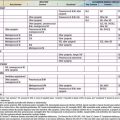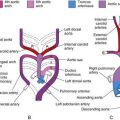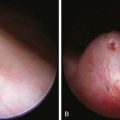Chapter 205 Other Anaerobic Infections
Clinical Manifestations
Anaerobic infections occur in a variety of sites throughout the body (Table 205-1). Anaerobes often coexist synergistically with aerobes. Infections with anaerobes are almost always polymicrobial and also include aerobes.
| SITE AND INFECTION | MAJOR RISK FACTORS | ANAEROBIC BACTERIA* |
|---|---|---|
| CENTRAL NERVOUS SYSTEM | ||
| Cerebral abscess | Cyanotic heart disease Cystic fibrosis Penetrating trauma |
Polymicrobial |
| Epidural and subdural empyemas | Direct extension from contiguous sinusitis, otitis media, mastoiditis | Bacteroides fragilis† Fusobacterium Peptostreptococcus Veillonella |
| UPPER RESPIRATORY TRACT | ||
| Dental abscess | Poor periodontal hygiene | Peptostreptococcus |
| Ludwig angina (cellulitis of sublingual-submandibular space) | Drugs that cause gum hypertrophy | Fusobacterium |
| Necrotizing gingivitis (Vincent stomatitis) | Prevotella melaninogenica | |
| Chronic otitis-mastoiditis-sinusitis | Tympanic perforation Tympanostomy tubes |
|
| Peritonsillar abscess | Streptococcal pharyngitis | |
| Retropharyngeal abscess | Penetrating injury | |
| LOWER RESPIRATORY TRACT | ||
| Aspiration pneumonia | Periodontal disease | Polymicrobial |
| Necrotizing pneumonitis | Bronchial obstruction | P. melaninogenica |
| Lung abscess | Altered gag or consciousness Aspirated foreign body Sequestered lobe Vascular anomaly |
Bacteroides intermedius Fusobacterium Peptostreptococcus, Eubacterium B. fragilis, Veillonella |
| Septic pulmonary emboli | Fusobacterium | |
| INTRA-ABDOMINAL | ||
| Abscess | Appendicitis | Polymicrobial |
| Secondary peritonitis | Penetrating trauma (especially of the colon) | Bacteroides spp. Clostridium Peptostreptococcus Eubacterium Fusobacterium |
| FEMALE GENITAL TRACT | ||
| Bartholin abscess | Vaginosis | B. fragilis |
| Tubo-ovarian abscess | Intrauterine device | Bacteroides bivius |
| Endometritis | Peptostreptococcus | |
| Pelvic thrombophlebitis | Clostridium | |
| Salpingitis | Mobiluncus | |
| Chorioamnionitis | Actinomyces | |
| Septic abortion | Clostridium | |
| SKIN AND SOFT TISSUE | ||
| Cellulitis | Decubitus ulcers | Varies with site and contamination with oral or enteric flora |
| Perirectal cellulitis | Abdominal wounds | Clostridium perfringens (myonecrosis) |
| Myonecrosis (gas gangrene) | Pilonidal sinus | Bacteroides Clostridia |
| Necrotizing fasciitis and synergistic gangrene | Trauma Human and animal bites Immunosuppressed or neutropenic patients Varicella |
Fusobacterium Clostridium tertium Clostridium septicum Anaerobic streptococci |
| BLOOD | ||
| Bacteremia | Intra-abdominal infection, abscesses, myonecrosis, necrotizing fasciitis | B. fragilis Clostridium Peptostreptococcus Fusobacterium |
* Infections may also be due to or may involve aerobic bacteria as the sole agent or as part of a mixed infection; brain abscess may contain microaerophilic streptococci; intra-abdominal infections may contain gram-negative enteric organisms and enterococci; and salpingitis may contain Neisseria gonorrhoeae and Chlamydia trachomatis.
† Bacteroides fragilis is usually isolated from infections below the diaphragm except for brain abscesses.
Central Nervous System
Meningitis is rare, but it has occurred in neonates and as a complication of infections of the ear and neck. Brain abscess and subdural empyema are usually polymicrobial, with anaerobes commonly involved (Chapter 596). Brain abscess occurs most often as a result of spread of infection from sinuses, middle ear, or lung.
Upper Respiratory Tract
Lemierre syndrome, or postanginal sepsis, is a suppurative infection of the lateral pharyngeal space, of apparent increasing prevalence, that often begins as pharyngitis (Chapter 176). It may complicate Epstein Barr Virus or other infections of the pharynx. It usually manifests as a unilateral septic thrombophlebitis of the jugular venous system with septic pulmonary embolization. Clinical signs include unilateral painful neck swelling, trismus, and dysphagia culminating with signs of sepsis and respiratory distress. Fusobacterium necrophorum is the most commonly isolated organism, although polymicrobial infection may occur.
Lower Respiratory Tract
Anaerobic lung abscess, empyema, and anaerobic pneumonia are most common in children who have disordered swallowing or seizures or in whom an inhaled foreign body is occluding a bronchus. Most children and adults aspirate oral contents during sleep and periods of unconsciousness. In most cases, lung cilia and phagocytes clear particulate matter and microbes. If the aspiration is of increased volume or frequency or a foreign body blocks normal ciliary clearance, normal pulmonary clearance mechanisms are overcome and infection ensues. In unusual cases, particularly in patients with poor dental hygiene, aspirated mouth contents may contain the anaerobe Actinomyces israelii, resulting in pulmonary actinomycosis (Chapter 182). This anaerobic pneumonitis is remarkable for traversing tissues planes, and affected patients often have distinctive fistulas of the chest wall overlying the area intrathoracic infection.
Intra-abdominal Infection
The entire digestive tract is heavily colonized by anaerobes. The density of organisms is highest in the colon, where anaerobes outnumber aerobes 1,000 : 1. Perforation of the gut leads to leakage of gut flora into the peritoneum, resulting in peritonitis involving both aerobes and anaerobes. Secondary sepsis caused by aerobes often occurs early. As the peritoneal infection is walled off, an abscess composed of both aerobes and anaerobes often forms. Secondary hepatic abscesses may then develop as complications of appendicitis, intestinal perforation, inflammatory bowel disease, or biliary tract disease. In children with malignancies who are receiving chemotherapy, the intestinal mucosa is often damaged, leading to translocation of bacteria and focal invasion of bowel flora. Typhlitis is a mixed infection of the gut wall usually beginning in the ileocecum and characterized by abdominal pain, diarrhea, fever, and abdominal distention in neutropenic patients. Empirical antimicrobial therapy of fever and neutropenia may not be optimal against the anaerobes involved in typhlitis (Chapter 171). Similarly, a mixed aerobic/anaerobic infection of the intestinal wall and peritoneum may develop in a small infant as a complication of necrotizing enterocolitis, believed to be due to relative vascular insufficiency of the gut and hypoxia (Chapter 96.2).
Skin and Soft Tissue
Clostridial myonecrosis, or gas gangrene, is a rapidly progressive infection of deep soft tissues, primarily muscles, associated with Clostridium perfringens. Necrotizing fasciitis is a more superficial, polymicrobial infection of the subcutaneous space with acute onset and rapid progression that has significant morbidity and mortality (Chapter 657.2). Group A streptococcus, known in the popular press as “the flesh-eating bacteria,” and Staphylococcus aureus are occasionally the causative pathogens. Commonly, necrotizing fasciitis is produced by combined infection of S. aureus or gram-negative bacilli and anaerobic streptococci, termed synergistic gangrene. This infection is often seen as a complication of varicella following secondary infection of cutaneous vesicles. Diabetic patients may have a particularly aggressive and destructive synergistic gangrene of the inguinal area and adjacent scrotum or vulva known as Fournier gangrene. Early recognition with aggressive surgical debridement and antimicrobial therapy is necessary to limit disfiguring morbidity and mortality.
Diagnosis
The diagnosis of anaerobic infection requires a high index of suspicion and the collection of appropriate and adequate specimens for anaerobic culture (Table 205-2). Culture specimens should be obtained in a manner that protects them from contamination with mucosal bacteria and from exposure to ambient oxygen. Swab samples from mucosal surfaces, nasal secretions, respiratory specimens, and stool should not be sent for anaerobic culture, because these sites normally harbor many anaerobes. Aspirates of infected sites, abscess material, and biopsy specimens are appropriate. Specimens must be protected from oxygen and transported to the laboratory immediately. An anaerobic transport medium is used to increase the likelihood of recovery of obligate anaerobes. Gram staining of abscess fluid from suspected anaerobic infections is useful because even if the organisms do not grow in culture, they can be seen on the smear. Methods for susceptibility testing exist but may not be routinely available. A rapid and easy screening test can be used to detect β-lactamase production and presumptive penicillin resistance.
Table 205-2 CLUES TO PRESUMPTIVE DIAGNOSIS OF ANAEROBIC INFECTIONS*
* Suspicion of anaerobic infection is critical before specimens are sample for culture, to ensure optimal microbiologic techniques and prompt, appropriate therapy.
Common Anaerobic Pathogens
Clostridium
Strains of Clostridium cause disease by proliferation and often by production of toxins. Of the > 60 species that have been identified, only a few cause infections in humans. The most frequently implicated species are Clostridium difficile (Chapter 204), Clostridium perfringens, Clostridium botulinum (Chapter 202), Clostridium tetani (Chapter 203), Clostridium butyricum, Clostridium septicum, Clostridium sordellii, Clostridium tertium, and Clostridium histolyticus.
Food Poisoning
C. perfringens type A produces an enterotoxin that causes food poisoning (Chapter 332). This intoxication results in the acute onset of watery diarrhea and crampy abdominal pain. The usual foods containing toxin are improperly prepared or stored meats and gravies. A specific etiologic diagnosis is rarely made in children with food poisoning. Therapy consists of rehydration and electrolyte replacement if necessary. The illness resolves spontaneously within 24 hr of onset. Prevention requires the maintenance of hot food at a temperature ≥ 74°C.
Bartlett AH, Rivera AL, Krishnamurthy R, et al. Thoracic actinomycosis in children: case report and review of the literature. Pediatr Infect Dis J. 2008;27:165-169.
Brook I. Clinical review: bacteremia caused by anaerobic bacteria in children. Crit Care. 2002;6:205-211.
Brook I. Microbiology and management of neonatal necrotizing enterocolitis. Am J Perinatol. 2008;25:111-118.
Craig FW, Schunk JE. Retropharyngeal abscess in children: clinical presentation, utility of imaging, and current management. Pediatrics. 2003;111:1394-1398.
Hecht DW. Evolution of anaerobe susceptibility testing in the United States. Clin Infect Dis. 2002;35(Suppl):S28-S35.
Jallali N, Withey S, Butler PE. Hyperbaric oxygen as adjuvant therapy in the management of necrotizing fasciitis. Am J Surg. 2005;189:462-466.
Kainer MA, Linden JV, Whaley DN, et al. Clostridium infections associated with musculoskeletal-tissue allografts. N Engl J Med. 2004;350:2564-2571.
Lin WJ, Lo WT, Chu CC, et al. Bacteriology and antibiotic susceptibility of community-acquired intra-abdominal infection in children. J Microbiol Immunol Infect. 2006;39:249-254.
Ramirez S, Hild TG, Rudolph CN, et al. Increased diagnosis of Lemierre syndrome and other Fusobacterium necrophorum infections at a children’s hospital. Pediatrics. 2003;112:e380-e385.
Petrillo TM, Beck-Sague CM, Songer JG, et al. Enteritis necroticans (pigbel) in a diabetic child. N Engl J Med. 2000;342:1250-1253.
Solomkin JS, Mazuski JE, Baron EJ, et al. Guidelines for the selection of anti-infective agents for complicated intra-abdominal infections. Clin Infect Dis. 2003;37:997-1005.






